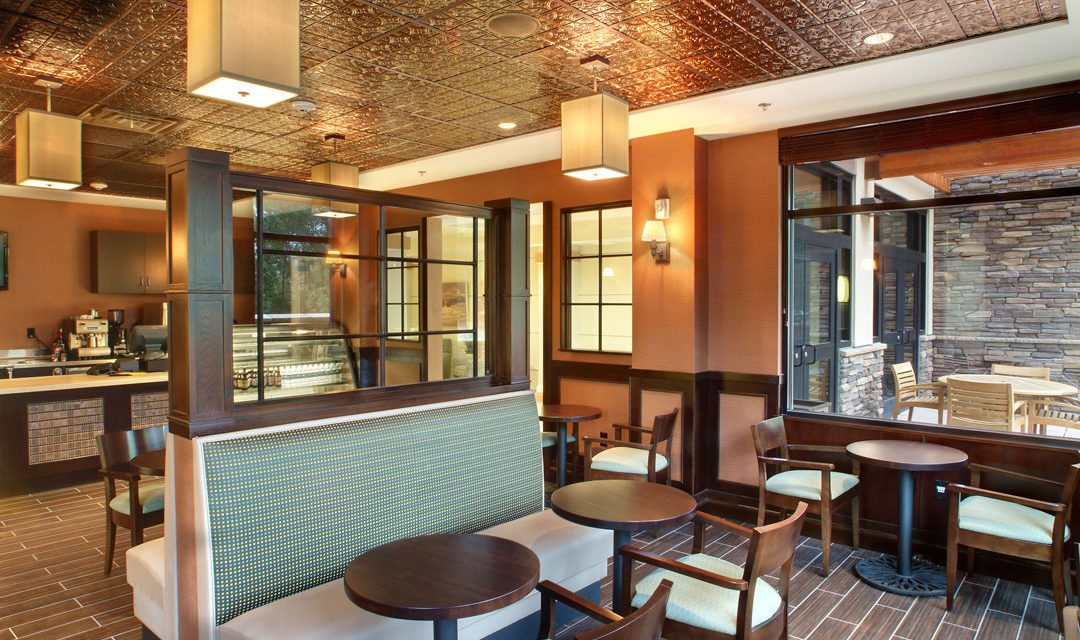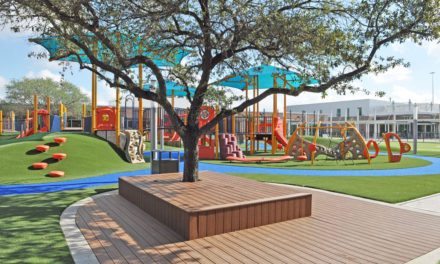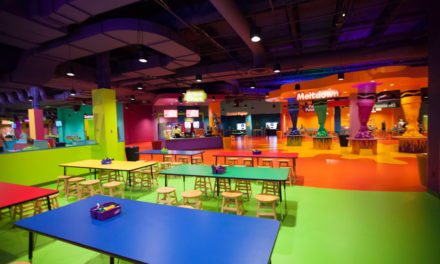One of the best ways to foster unity across different ages and backgrounds is to eat together. The simple act of breaking bread can bring people closer, with opportunities to converse, share and enjoy one another’s company. In a senior living space, a warm and welcoming dining area can help draw in visitors, foster social engagement and create a more elevated experience centered around the tried and true tenets of restaurant hospitality.
That said, many senior living operators have begun to rethink their dining area design. Instead of conventional cafeterias, they are introducing more diverse and dynamic options that take after actual restaurants and foster more of a “destination” feel.
These dining room design details may be second nature for most restaurant operators. However, even with a renewed effort toward improving and expanding the dining experience, senior living and assisted living operators often don’t know where to start. By pairing an experienced restaurant designer with a senior living designer and architect, we’ve come up with the following five tips and suggestions for creating welcoming, comfortable dining spaces inspired by the world of restaurant design.
Acoustics
Acoustics may not typically be at top of the priority list, but they really should be. According to Zagat’s State of American Dining in 2015, noise is the second most common complaint among restaurant-goers (after bad service), and the impact poor acoustics can have on senior living residents are obvious.
Designs that incorporate high ceilings, wood floors and a lot of windows can increase noise substantially, which can make dining an isolating, rather than social, experience, especially for seniors who are often hard of hearing. Make an effort to avoid an abundance of hard-surfaces, as they can cause sounds to ricochet around the room and echo. Treating the ceiling is one of the best solutions for sound control. The addition of acoustical ceiling tiles or dropped clouds (panels that hang from the ceiling and capture and absorb sound) can be enormously helpful.
Also, be sure to keep music in mind. The type and volume of music should match the personality of the space. Soft music makes people feel more comfortable having intimate conversations, while louder music may create a more fun atmosphere in a bar or bistro setting.
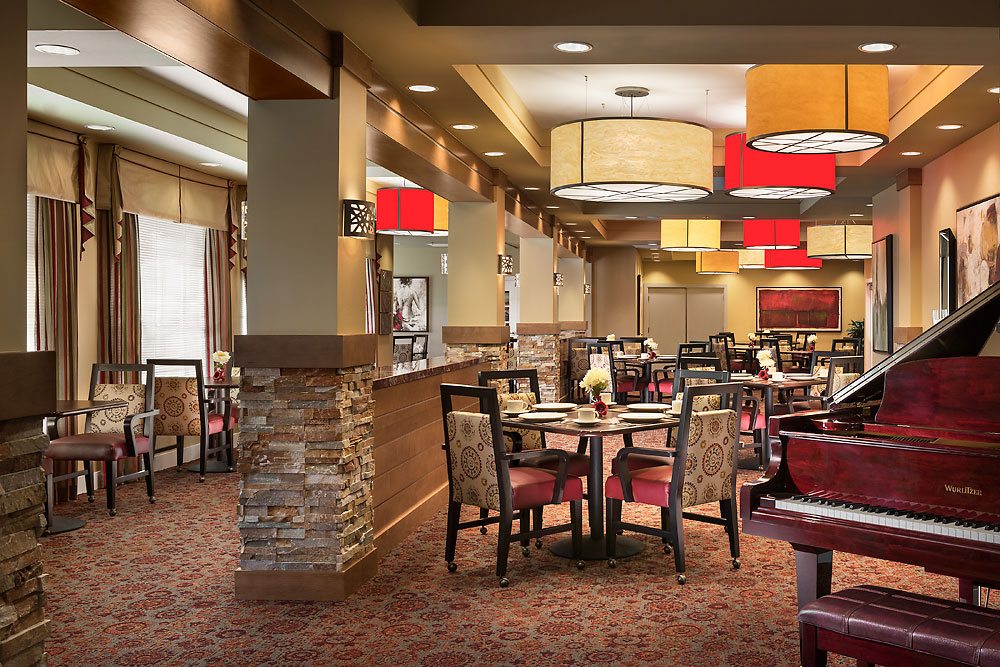
Lower ceilings and softer surfaces like carpet and curtains, such as these in a Glendale, Arizona MorningStar senior living community, help capture and absorb sound for a better dining experience. Photo credit: Mark Boisclair Photography
Natural and artificial lighting
When people think of eating in a retirement or assisted living community, it often calls to mind the stereotypical image of a depressing, fluorescent-lit, oversized room. Incorporating both natural and artificial lighting is one of the best ways to combat this cliché and create a welcoming environment that feels more like a traditional restaurant and less like a cafeteria.
Windows with a pleasant exterior view are a huge part of establishing an inviting setting, though care should be taken to avoid too much glare, which can be challenging for seniors. Window coverings should be adjusted throughout the day, and interior materials like carpet and fabric can help reduce sun glare on hard surfaces.
In addition, indirect ambient lighting such as cove lights are a great way to create a softer, less harshly-lit atmosphere, as is the use of accent lighting to bump up and highlight key areas like individual tables or art on the walls.
In terms of color temperature, 2700K is what most restaurant operators strive for, as it emits a nice, warm light that will enhance the dining experience. Being mindful about lighting also means being aware of potential light pollution and making efforts to avoid having light enter the dining space from the kitchen, the exterior and other adjacent areas. Unintentional lighting can shine harshly in the eyes of diners, or accidentally cast people’s faces or food in an unflattering light.
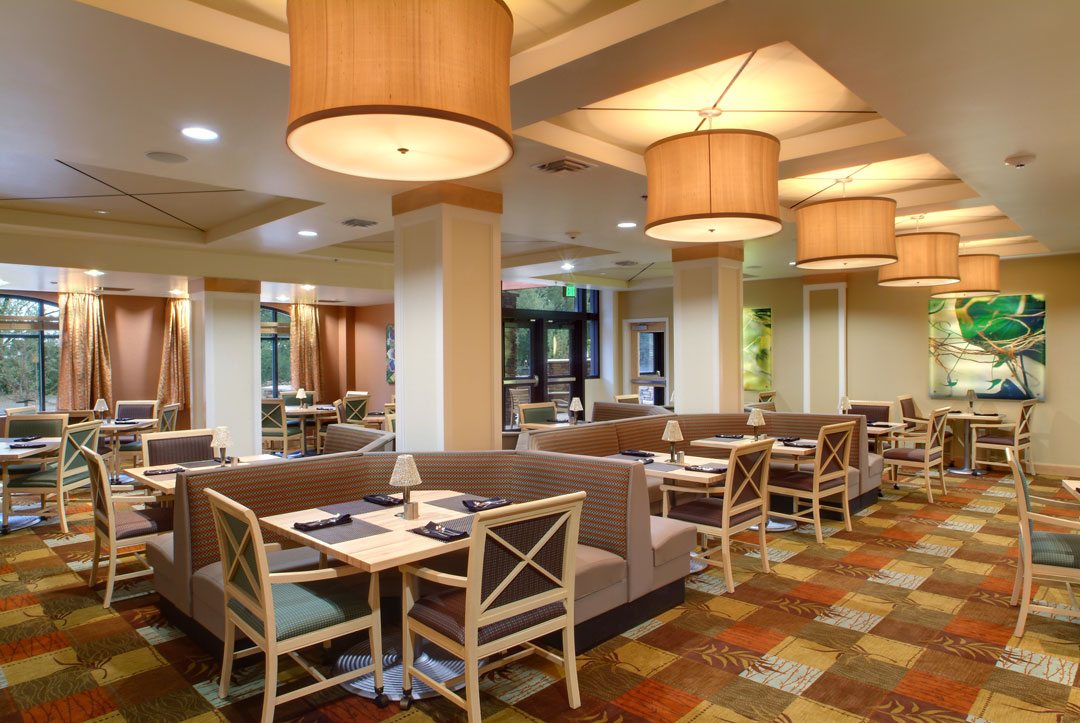
This dining room at the Carillion at Boulder Creek in Boulder, Colorado incorporates both natural and artificial lighting. This is one of the best ways to create a dining space that feels more like a restaurant and less like a cafeteria. Photo credit: Fred J. Fuhrmeister for OZ Architecture
Open kitchen design
Open country-style kitchens are a huge trend in restaurant design right now, and are commonly used in memory care communities where kitchens are smaller and meant to integrate staff and residents for a more intimate, interactive meal service. That said, before using an open kitchen design, it’s critical to ensure proper ventilation. The more open the kitchen is, the better the ventilation system needs to be. Appliances like ovens, some dishwashers and even high-end mixers can require venting, along with restrooms that are in the dining room or adjacent to it. It’s important to think through all of those elements in the early design stages and ensure that you’re not venting noxious odors onto an outdoor patio or other areas of the community. Carbon filters or “scrubbers” are commonly used in restaurants to help neutralize the air coming out and ensure cooking or restroom smells don’t spill over into undesirable places.
Precise space planning
Precise space planning is one of the chief concerns of restaurant designers, and is equally key in senior living centers, where the square footage allotted per person differs from a traditional restaurant. Whereas most full-service restaurants plan for 12-15 square feet per person when planning potential seat count, a senior living community should anticipate needing 20-30 square feet per person for independent living, 30-40 for assisted living, and 40-50 for residents who suffer from memory loss or require skilled nursing.
Circulation patterns for both staff and residents – from tables to restrooms, kitchen to tables, and tables to the main entrance and exit – should be clear and plotted on a “circulation map” ahead of time. This is especially important in senior living where pathways must remain open for residents with mobility devices. What’s more, circulation patterns can be affected by the style of dining, such as buffet lines or counter service versus traditional table service. Typically, allowing enough room for one wheelchair or walker “parking” space per table is preferable.
Additionally, furniture spacing between tables should be between 48”- 60” depending on the community’s occupancy type. For example, 48” aisles are acceptable for independent living where mobility devices are less prevalent, while 60” aisles would be appropriate for assisted living and memory care where walkers and wheelchairs are more commonly used.
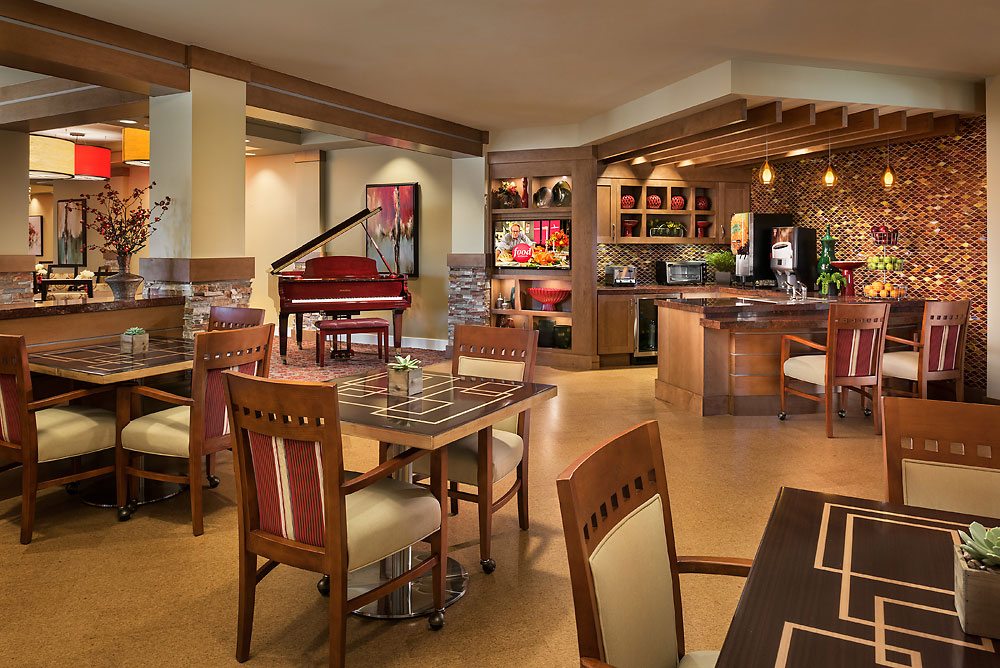
Incorporating small, casual spaces that feel more like a cafe or bistro give senior living residents more options when it comes to dining. Photo credit: Mark Boisclair Photography
Trends in the restaurant world
Some of the top food trends in the restaurant world can also be integrated into senior living communities. One of the most popular concepts is “theater dining,” or an open kitchen where patrons can watch the action as a form of entertainment. In a senior living space, this could include a lowered counter along a central island near the kitchen where residents can pull up a chair or wheelchair, converse with kitchen staff or care providers, and even potentially engage in meal prep. Dim sum carts where diners can choose dishes off carts that travel through the restaurant are also in vogue and a great idea for senior living communities where patrons may prefer to see their options presented to them rather than strain to read off a menu. Farm-to-fork dining continues to gain momentum, with a focus on fresh, local and seasonal ingredients and simple but high-quality dishes. The recent interest and excitement around craft cocktails goes hand in hand with this uptick in desire for artisanal, small-batch food. Craft cocktails are also an easy menu add that can help create a hand-crafted, upscale ambiance.
When it comes to designing and planning senior and assisted living dining areas, there are many ways to draw inspiration from the restaurant and hospitality worlds. By incorporating these extra details and offerings into the dining room and service style, operators can achieve an environment that is more enjoyable, social and memorable for residents and visitors alike.
About the authors

Megan Freckelton
Megan Freckelton
Megan Freckelton is a senior associate and restaurant interior designer at OZ Architecture in Denver, Colorado, where she has led the interior design of approximately 30 restaurants. She can be reached at mfreckelton@ozarch.com.

Jami Mohlenkamp
Jami Mohlenkamp
Jami Mohlenkamp is a Principal at OZ Architecture and the leader of the firm’s Senior Living practice area. He is passionate about creating spaces that elevate the daily living experience, enable aging in place, and allow for independence and wellness of residents. He can be reached at jmohlenkamp@ozarch.com.
OZ Architecture
Colorado-based OZ Architecture has been creating innovative, collaborative, and timeless architecture around the world since 1964. The firm has completed projects in nearly every continent, and is known for designing globally-recognized, award-winning buildings that offer the best solutions for clients and make a lasting contribution to the communities they’re in. OZ has a team of more than 150 diverse and passionate architecture and design professionals whose work spans a wide range of practice areas. From resort and hospitality to urban living and higher education, OZ designs it all and has a reputation for creating elegant, timeless solutions. For more information, visit www.ozarch.com.

